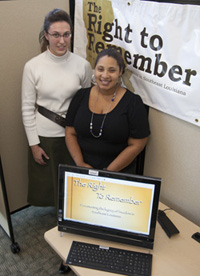Recording the past: A look at the Civil Rights movement...
On the home page...
Click on the thumbnail for a larger picture.
Communication Interim Department Head Suzette Bryan and communication professor Amber Narro help students Tiffany Baptiste and Megan Mosher navigate through the “Narrating the Silences” listening station located in the Sims Memorial Library. The station, which features videos, pictures and articles from the civil right movement, was created by a special topics communication course taught by Narro and funded by a University of Louisiana System Learn and Serve Grant.
Suzette Bryan, Interim Head, Department of Communication
Amber Narro, Assistant Professor of Communication
Megan Mosher, Loranger, senior
Tiffany Baptiste, New Orleans, senior
Nearly 60 years after the start of the civil rights movement, the experience remains a significant memory to many who fought for racial equality. For mass communication majors Tiffany Baptiste and Megan Mosher, the opportunity to explore civil rights during a communications course gave them a greater appreciation for the Louisianans who were front and center in the movement.
As part of “The Right to Remember” project, students from communication professor
Amber Narro’s special topics course collected information from local civil rights
activists and disseminated the information through various media forms, including
a documentary and magazine.
Funded by an $11,500 University of Louisiana System Learn and Serve Grant matched
by the university, the project was a partnership between Southeastern and the Tangipahoa
Chapter of the National Association for the Advancement of Colored People (NAACP).
|
|
|
|
Senior mass communication majors Megan Mosher of Loranger (left) and Tiffany Baptiste of New Orleans (right) stand behind the “Narrating the Silences” listening station. The station was developed as part of “The Right to Remember” collaborative project between the Department of Communication and the Tangipahoa Chapter of the NAACP. |
|
“I originally thought, ‘these are the people who have been involved and have compelling stories’ but that we just didn’t have anyone to collect their narratives,” said Interim Communication Department Head Suzette Bryan, who also wrote the grant. “I thought it was a good idea. I hoped the students would understand the sacrifices people have made for us to be where we are today.”
The project goal was definitely met.
Mosher, a senior mass communication major from Loranger, said the project was an
enlightening experience because she had never really thought about civil rights as
a local issue before enrolling in the course.
“When you think of civil rights, you think of Rosa Parks or Martin Luther King, Jr.
but you never really think of it happening in your hometown,” she said.
Baptiste, a senior mass communication major from New Orleans, added that the project
was an eye-opening experience.
“Going to this school has taught me a lot about race relations,” Baptiste said. “Being
in this class, there were some really interesting conversations that came up and it
was a huge surprise to me that so many local people were involved in civil rights.”
Narro said that the project taught the class that the movement was more than a black
and white issue.
“This project took a local effort and combined it with what was really happening
on a national scale,” Narro said. “This was really a historical project because we
were able to find out how we fit in locally and learned that civil rights is an issue
that affects everyone.”
In addition to producing newspaper articles, a blog on nola.com, a documentary and
magazine, students also collected information for a listening station located on the
second floor of the Sims Memorial Library.
Titled “Narrating the Silences,” the listening station features student-conducted
interviews of Tangipahoa civil rights activists, news articles, PowerPoint presentations,
pictures and videos collected during the semester-long course. The station will be
a permanent fixture in the library and will be added to as more information is collected
through related university courses and events.
“Dr. Narro told the students they would be giving something of permanent value to
the university that would have their name on it,” Bryan said. “It is a lasting tribute
to the students, the participants and Southeastern.”
Interviews featured on the listening station include Patricia Morris, current president
of the Tangipahoa NAACP, and Rev. Edward “Chipps” Taylor, a one-time affiliate of
the Black Panthers.
“I learned a lot as the teacher of the class,” Narro said. “There were so many groups
who didn’t have a voice at that time but came to light through the movement and the
African-American stamp on that.”
Narro added that the course was a challenge for students who had to work hard and
push themselves to complete tests, quizzes and papers in addition to the project.
Baptiste agreed. “The most difficult part was pulling the people together and finding
the time to perform interviews on top of regular school work and other classes,” she
said.
Although the class was challenging, both students said they hope to pursue communication
careers. Mosher said she hopes to work at a newspaper, while Baptiste would like to
become a radio personality or work behind the scenes in television.
“I think we learned as a group that it’s not over, that’s it’s not something we can
bury; but we also learned that there were a lot of peaceful things that were done
that were again part of people’s sacrifices,” Narro said.
“I think knowing what happened in the past and where we’ve come from helps us define
where we are now,” Mosher said.
More Homepage Stories...


